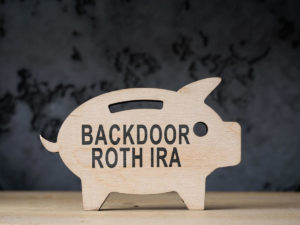
By Eric Coons
Roth IRAs arrived as a retirement savings option in 1998 to great critical acclaim. Financial professionals lauded the tax-deferred growth and tax-free earnings withdrawals of Roths. Another popular feature of these accounts was that they were not subject to required minimum distributions (RMDs.) Initially, Roths weren’t that widely available. There were several income/filing status limitations to contributing or converting.
In 2010, the income/filing status limitations ended, making it easier for owners of traditional IRAs to convert to Roths and beneficiaries of traditional IRAs. When you thoroughly comprehend the tax advantages of Roths, you’ll realize they can be a powerful tool in retirement planning for many people. However, you need to be aware that backdoor Roths may come with some unexpected tax complications that you and your financial advisor must address ahead of time.
How does a “backdoor” Roth (conversion) work?
Wealthier individuals and couples who want a Roth’s tax benefits but are over the maximum income thresholds sometimes turn to Roth “conversions.” That’s because there are no limits on how much you can convert to a Roth. The idea here is to use funds in a traditional IRA and pay the tax bill now on the amount transferred. By doing this, you can profit from having tax-free growth of your money until you retire.
This conversion process is sometimes called a “backdoor” Roth IRA.
Unfortunately, as is often the case, what the IRS giveth, it may also taketh away. Many retirement savers, even the savviest, more well-informed people, are unaware of some tax issues that backdoor Roths may trigger. For instance, many assume that since you’re using after-tax money to fund a Roth, moving tax-deferred funds into a Roth means you’ll only pay taxes on the amount you convert. However, that is only true if you’ve never topped up your traditional IRA with after-tax money.
Suppose you have, like many folks, contributed non-deductible funds to your regular IRA. In that case, your Roth conversion taxes may be more complicated than you ever imagined due to the “Pro-Rata Rule.”
What can the Pro-Rata rule do to your tax bill?
Based on formulas used by the IRS to decide the amount of tax-deferred money subject to taxes when withdrawn, the Pro-Rata rule applies to backdoor Roth conversions. That’s because you are transferring traditional IRA money to a Roth IRA.
This situation is pretty straightforward. If you have contributed after-tax money to a traditional IRA, the total amount converted to a backdoor Roth is taxed at your regular income tax rate. But, if you have a traditional IRA that is a mixture of both after-tax (non-deductible) and pre-tax (deductible) dollars, the Pro-Rata Rule requires that your conversion is proportionately taxed to pre and post-tax percentages.
The Pro-Rata rule keeps people from doing an end-run around Roth income limits and maneuvering their funds to lower the tax liability. The Pro-Rata Rule does not allow you to choose which funds you convert.
How is your taxable percentage calculated?
John has $100,000 in his traditional IRA. $10,000 came from non-deductible contributions, meaning John already paid taxes on $10,000. The IRS will not make him pay taxes on that $10,000 twice.
John, however, mistakenly believes that since he already paid taxes on that $10,000, he can convert $10,000 of his traditional IRA to a Roth IRA without paying taxes again. But, it’s not that simple because the Pro-Rata rules say you can’t decide that your Roth conversion will only use those after-tax funds. Since John wants to convert $10,000 to a backdoor Roth, he must first calculate how much of his IRA money is taxable. In his case, 10% of the $100,000 is non-taxable since he already paid those taxes.
But, when John goes to convert that $10,000 to a Roth, the converted amount is actually coming from 90% pre-tax money, with only 10% after-tax funds. John will have to pay taxes on the 90%, not 10%. That’s a huge difference. And, if he makes future after-tax contributions to his non-Roth IRA accounts, John will need to re-calculate those amounts.
As you can see, the Pro-Rata rule could trip you up if you don’t know the tax implications before converting.

Bottom line: Some per-retirees think they can contribute after-tax dollars to their traditional IRAs and convert that money to a Roth, bypassing income limits. However, the IRS’ Pro-Rata Rule keeps them from doing this. The Pro-Rata Rule requires you to calculate your taxable contribution percentage. You will then pay a proportionate amount when you withdraw from tax-deferred accounts. You must understand and address the Pro-Rata Rule, or it may result in an unexpected tax bill for savers.





